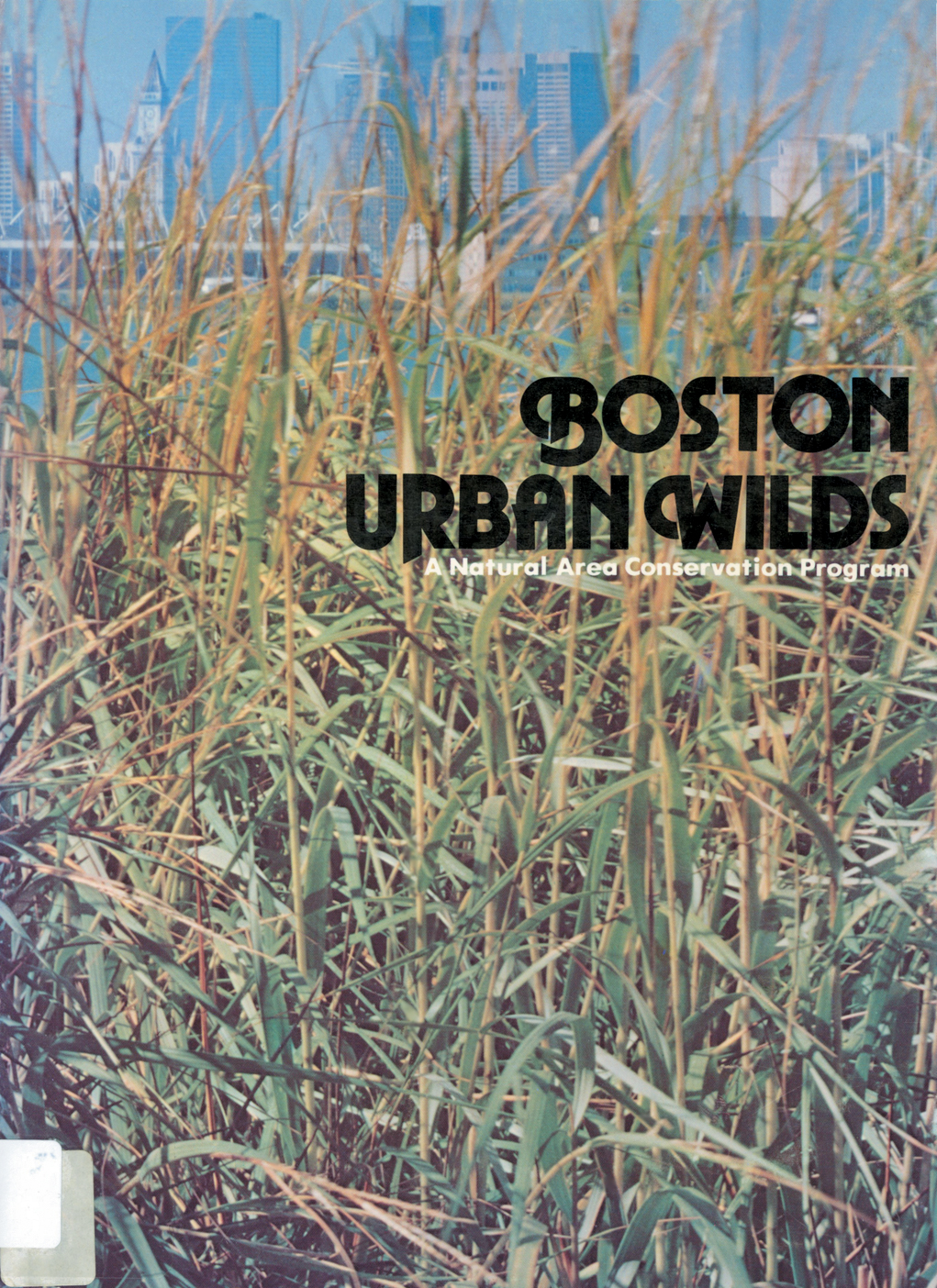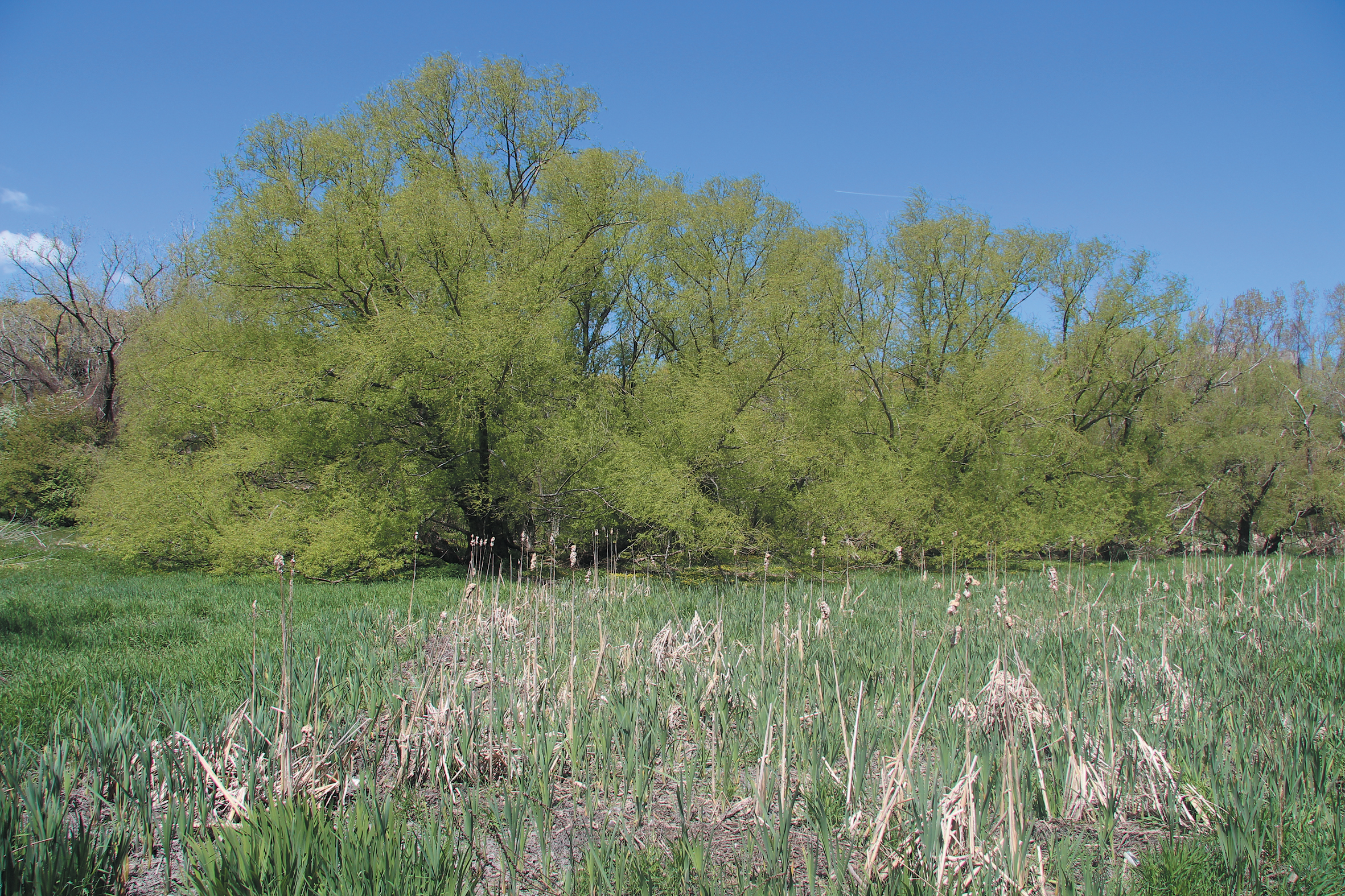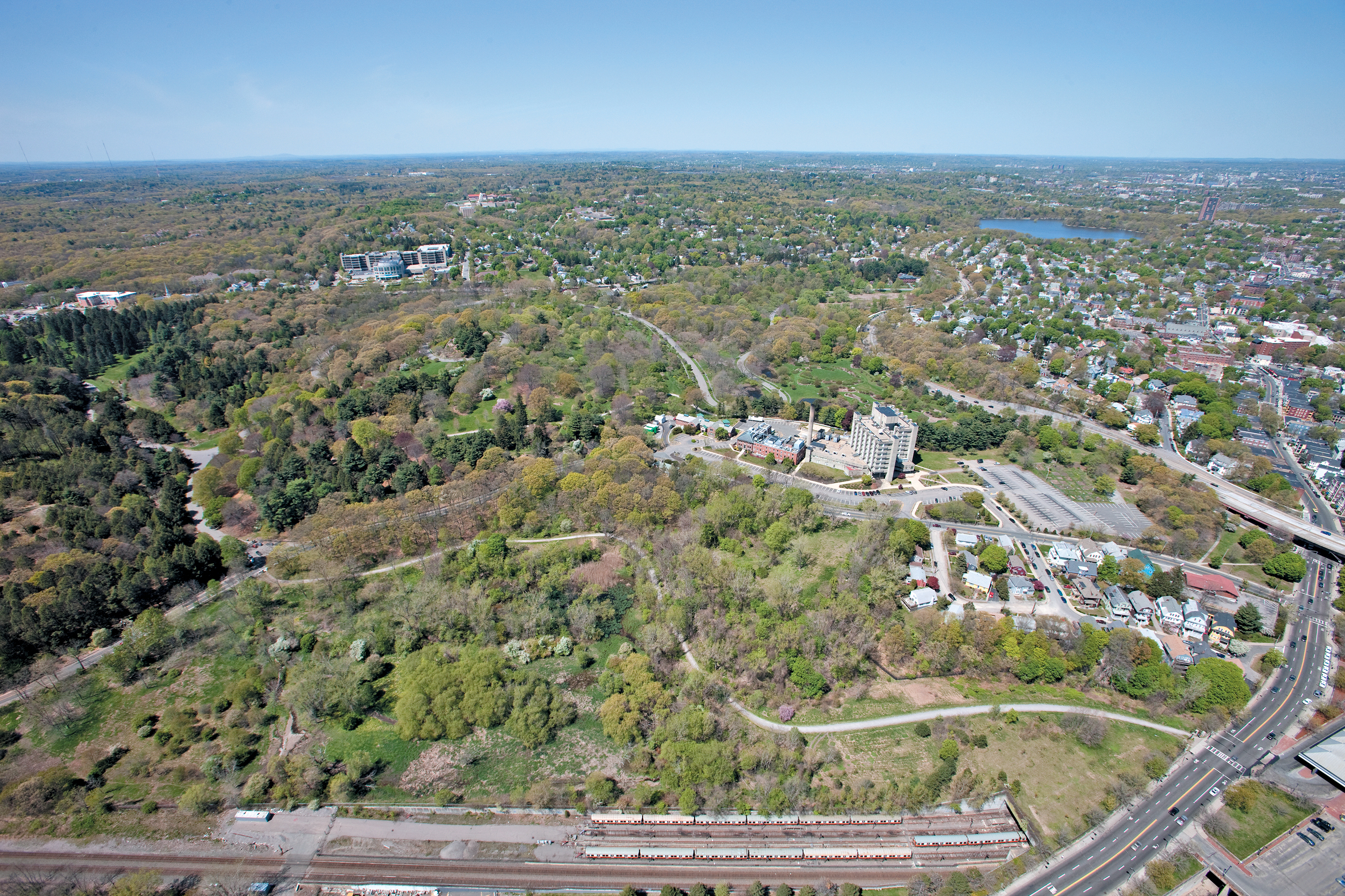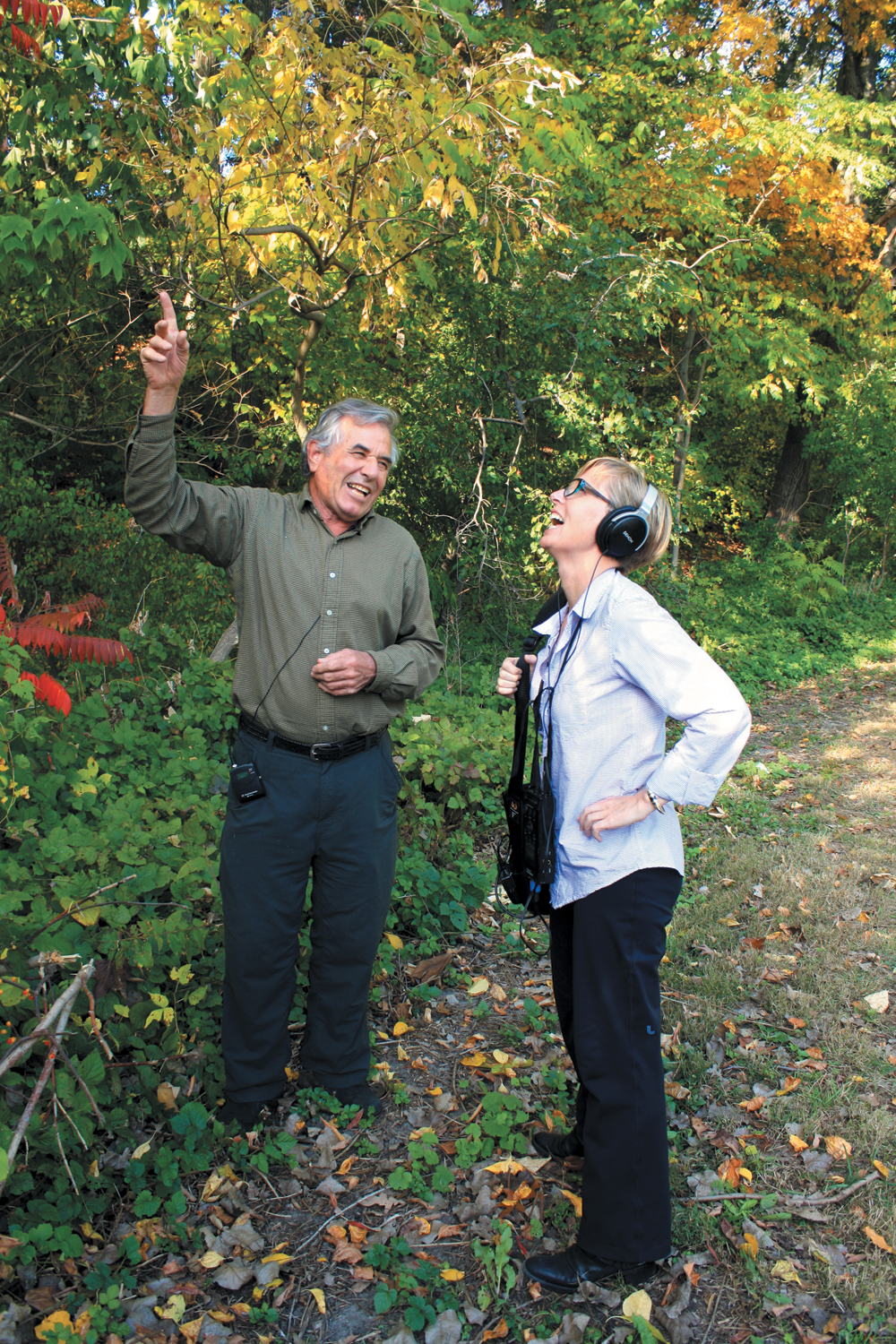In urban areas, vegetation that is not planted or maintained by people—including both native and non-native species—typically dominates many different habitats including river and stream banks, highway verges, vacant building lots, infrastructure edges, chain-link fence lines, and random pavement cracks. For most cities, the amount of spontaneous vegetation they support varies inversely with their economic prosperity; cities that have lost the most population and jobs show the highest levels of land abandonment and volunteer plant growth (Del Tredici 2010a, b; Burkholder 2012).
How city dwellers respond to the presence of spontaneous vegetation in their midst is influenced by personal preferences as well as by cultural norms. In many European cities, residents’ feelings about spontaneous vegetation is divided—some welcome it as a manifestation of unrestrained urban nature while others see it as an indicator of dereliction that should be removed. Such responses have led to the categorization of urban residents as either “nature lovers” (a.k.a. wilderness enthusiasts) or “neat freaks” (a.k.a. urban devotees). Interestingly, the percentages of people in these categories can vary dramatically from one city to the next in the same country (Keil 2005; Rink 2005; Weber et al. 2014).
In an effort to promote a wider appreciation and acceptance of “urban wilds,” urban ecologists have recently been attempting to calculate the value of the ecosystem services provided by spontaneous vegetation, especially in cities where the population is shrinking and the amount of vacant land is expanding (Pataki et al. 2011; Burkholder 2012; Robinson and Lundholm 2012). On the positive side, this vegetation contributes to increasing the ecological functionality of the city in terms of storm water management, temperature reduction, carbon sequestration, soil development, and total biodiversity (Kowarik and Körner 2005; Carroll 2011). Harder to quantify, but nevertheless important, are the opportunities for social, cultural, educational, and nature experiences that spontaneous vegetation provides across the wide array of cultural contexts and sites that characterize most cities (Pfeiffer and Voeks 2008; Daniel et al. 2012; Jorgensen and Keenan 2012).
The aesthetics of spontaneous vegetation are usually considered negative given that much of it is perceived as ugly or messy (i.e., lacking ornamental characteristics or possessing an unkempt appearance), and its presence in the landscape is justifiably viewed as projecting an image of neglect (Nassauer and Raskin 2014). In the arena of public health, many people see spontaneous vegetation as providing habitat for animals that are vectors for a number of human pathogens and infectious diseases such as rats, mosquitoes, and ticks (Garvin et al. 2012; Gulachensik et al. 2016). Similarly, the large size that spontaneous urban vegetation can reach in the absence of maintenance is viewed as providing cover for potential criminal activity and thus a threat to public safety. To the extent that urban landscapes dominated by spontaneous urban vegetation are perceived as threatening, they fit within a concept of a “wilderness” that is defined as land that exists outside the bounds of human control (Hofmeister 2010; Jorgensen and Keenan 2012; Desimini 2015).
In this article we will explore the history of the “urban wilds” construct as it developed in Boston, Massachusetts, from its introduction in the mid-1970s through today, and present a case study of one such site, Bussey Brook Meadow at the Arnold Arboretum, to illustrate how multi-faceted urban wilds can be creatively interpreted for the general public utilizing GPS (global positioning system)-based cell phone technology.



Urban Wilds in Boston
In the United States, the idea that unmanaged “open space” in cities could perform valuable ecological services was foreshadowed by a movement in the 1970s that categorized such sites as “urban wilds” (Tanner 1975; Desimini 2015). In 1976, the Boston Redevelopment Authority (BRA), a city planning agency, officially adopted the term when it issued an inventory of Boston’s unimproved and unprotected natural areas under the title Boston Urban Wilds. The report—which was partially funded by a grant from the National Endowment for the Arts—was spearheaded by BRA landscape architect Elliot Rhodeside. It identified 143 parcels of land (2,000 total acres) of diverse sizes and ownerships that contained significant “natural resource value” but were threatened by on-going development pressure (BRA 1976). Most of the sites had histories of industrial, institutional, or residential use, some dating back to the nineteenth century. Rhodeside left the BRA shortly after the report was published and the work of advocacy, fundraising, and protection for the Boston Urban Wilds project passed to a non-profit organization, the Boston Natural Areas Fund (BNAF), founded in 1977 by Eugenie Beal (the head of the then newly formed Boston Conservation Commission) along with her future husband, John Blackwell.
In its early days, BNAF was focused on trying to preserve and protect properties listed in the Urban Wilds report, but over time the emphasis of the organization shifted away from land acquisition to maintenance of already protected properties and coalition building with other non-profit organizations around issues of public advocacy. In 1988, the Boston Parks Department officially took over management of the Urban Wilds program which, as of 2014, listed 39 properties in its inventory. The Parks Department currently provides maintenance and logistical support for those properties that are controlled by the city; other properties on the list receive varying levels of maintenance depending on the resources allocated by the organization that controls it (Bird 2014).

The original 1976 BRA report described 143 sites that contained some significant “natural resource value,” including geological features (68 sites), coastal or fresh water wetlands (20 sites), shorelines (27 sites), or important vegetation (28 sites). It was clearly a simpler time when the meaning of the words nature and natural were not contested and the dichotomy between native and exotic species had yet to emerge as the divisive issue it is today. In the 1970s, urban wilds, regardless of their biological content or cultural history, were viewed as valuable antidotes to blighted, barren cityscapes. By the late-1990s, the original concept of an urban wild became subsumed under the rubric of ecological restoration. This reconceptualization of urban nature—essentially attempting to affix a “native” label on it—represented a dramatic reversal of fortune for the non-native organisms that found themselves reclassified as invasive species. Older, less value-driven terms to describe these plants, including weed, pest, naturalized species, garden escapee, volunteer, etc., fell by the wayside and with them an appreciation of their historic connection with the past land use of the site (Del Tredici 2010b).
This privileging of native over non-native species has created problems for today’s advocates of urban wilds because many of the sites they’re striving to protect can no longer be “restored” to anything resembling their original ecological condition (Del Tredici 2010a, b; Carroll 2011). Similarly, the ways that some people use minimally maintained urban wilds, including drinking, doing drugs, having sex, painting graffiti, and camping out, has also caused problems for advocates because of complaints from abutting residents and other users. Like it or not, urban wilds are places where human behavior, like the plants and animals that occupy them, can sometimes be out of control (Keil 2005; Thompson 2012).

Bussey Brook Meadow
Bussey Brook Meadow of the Arnold Arboretum of Harvard University was listed as an urban wild in the 1976 BRA report. This 25-acre wetland has a documented history of land use going back 350 years when, in 1662, one of the first roads leading southwest out of the city of Boston was constructed along its western edge. This road opened the land up to farmers who drained portions of the property and moved the stream, Bussey Brook, that ran through the middle of it to the periphery. A hundred and forty years later, in 1802, another road was built along its eastern edge, which eventually developed into a railroad line that is still in operation today. Once a stable earthen berm was constructed for the rail line in 1873, Bussey Brook was effectively isolated from the larger, adjacent Stony Brook watershed that drains into the Charles River. Following this, the processes of fragmentation and filling of Bussey Brook Meadow accelerated dramatically, most notably with the installation in 1900 of a 9-foot-diameter, 3,600-foot-long high-level sewer line across the western edge of the property and the construction of an expanded Forest Hills train station to the north in 1909 (Arnold Arboretum).
The Arnold Arboretum, through a land purchase from its Harvard University parent, acquired roughly half of the Bussey Brook Meadow parcel in 1919 and constructed Muddy Pond in the middle of the site, a wagon road following the track of the high-level sewer line, and a tree nursery on the site of former agricultural land. All of these activities over a period of seven years resulted in more wetland filling and disruption of surface drainage. In the 1950s, a privately owned esker on the site, composed mainly of sand and gravel, was excavated for construction purposes and replaced between 1955 and 1965 with a 5-acre landfill consisting of construction debris from the demolition of several Boston public schools. In 1971, after an unfortunate incident in which two neighborhood children from a nearby public housing project drowned, Muddy Pond in the center of the Arboretum’s portion of the wetland was filled in (Arnold Arboretum).
In 1982, the northern end of Bussey Brook Meadow underwent a major transformation when an expansion of the Forest Hills train station was initiated in order to make room for the new Orange Line subway station. As part of this project, a pathway was built along the base of the landfill that linked the new subway station to the South Street gate of the Arboretum. In 1996, through the determined efforts of Eugenie Beal and John Blackwell and the two non-profit organizations they co-founded (the Boston Natural Areas Fund and the Arboretum Park Conservancy), the deeds to the variously owned parcels of Bussey Brook Meadow were bundled together and added to the Arnold Arboretum’s 1882 indenture, thereby achieving permanent protection for the entire 25-acre site. At the same time, grants from federal, state, and city agencies, together with funds generated by the Arboretum Park Conservancy, were used to construct granite entrance gates and upgrade the surface of the main pathway, now christened Blackwell Path.
In 2011, the Arboretum, in keeping with its scientific research mission, approved a plan that called for turning Bussey Brook Meadow into a site for long-term environmental monitoring and research on urban ecology. While this meant that most of the land in Bussey Brook Meadow would be left alone to follow its own ecological trajectory, the Arboretum made a commitment to manage portions of the site that were heavily used by visitors, including mowing the edges of Blackwell Path regularly, removing hazard trees that threatened public safety, and mowing several meadow areas annually to keep woody vegetation from taking over (Arnold Arboretum).

Creating the Other Order Sound Walk
Having developed a long-term strategy for the site, the Arboretum still had to contend with issues raised by discordant visitor perceptions of the land. Some saw Bussey Brook Meadow as a “natural” counterpoint to the well-maintained landscape of the Arnold Arboretum proper, while others saw it as a haven for invasive species that undermined the Arboretum’s moral authority on matters of ecology. It was into this breech that the authors of this article stepped in 2012 with a proposal to interpret Bussey Brook Meadow for the general public using a GPS-based sound walk designed for use with a cell phone. The purpose of the proposed app was to illuminate the complex cultural history of Bussey Brook Meadow, to reveal the complex ecological interactions that are currently taking place on the site, and to show some of the ways the site was being used by the general public. The ultimate goal of the project was to try and change how people thought and felt about the site—to help them see that it was not just a chaotic collection of weeds but a dynamic, organized ecological system that reflected cultural values, past land-use history, and future ecological trajectories (Rueb and Del Tredici 2014).




The Other Order app took two years to complete and involved a close collaboration between Del Tredici, who provided extensive verbal interpretation of the site in situ, and Rueb, who recorded this material and combined it with field recordings to create a soundscape designed for delivery via a downloadable mobile app. The app uses GPS to track visitors’ movements and play the sounds at specific locations in Bussey Brook Meadow as they pass through them. In addition to Del Tredici’s monologues on “cosmopolitan” vegetation, recordings included dozens of on-site conversations with various experts, stakeholders, Arboretum staff, and park visitors including urban ecologists, park advocacy groups, multi-generation urban farmers, landscape architects, dog walkers, commuters, and transient residents.
Over twenty hours of ambient field recordings of the environment were also incorporated and used as inspiration for sound compositions evoking, for example, the material layers of the landfill, the interior sounds of the high level sewer pipeline, the leisure activity of past visitors mingled with those of the present, and the wildlife of the meadow. In some places one might find unexpected sounds such as light snoring tucked under a tree-of-heaven grove (Ailanthus altissima) near a concrete overhang, a flute mingling with sounds of laughter in a clearing in the center of the old Arboretum nursery, cows lowing and chickens clucking near the site of the former Bussey farmstead, and the sound of underwater gurgling as captured with hydrophones dropped into Bussey Brook. All of these sounds reference actual and imagined ways in which the meadow has been inhabited over time and the various materials and organisms that make up the complex social, biological, and physical matrix that is Bussey Brook Meadow.
Sound regions are arranged throughout the meadow in a manner that allows for a complete experience should visitors constrain their movements solely to Blackwell Path, which takes about twenty minutes to traverse at a leisurely pace. However, additional sound regions are spread throughout the meadow, rewarding the more adventurous and patient with sounds that may be accessed only by leaving the trail behind and following informal footpaths, trails, and tunnels through the dense vegetation.
Blackwell Path is an egalitarian corridor that connects the elegant environs of the formal Arboretum with the urban hubbub of the Forest Hills subway station and surrounding neighborhoods. Intervening into this path system represents a critique of conventional parks as much as an invitation to go off the beaten track and explore the wilds held within this “urban wild.” Bussey Brook Meadow is a particularly complex social site as it sits somewhere between a managed botanical garden on the one hand, and an interstitial zone where commuters, neighborhood residents, and tourists from all over the world mix with transient populations who are often staying for extended periods of time or returning each year with the milder seasons to regular encampments.

A central concern of the work is to communicate a variety of perspectives on place as a means of critically engaging contested meanings, uses, and inhabitations of public sites. Voices in the work range from those of experts who tell us what to look for, what to hear, and what to value in this richly vegetated environment, to those that offer meandering impressions, personal histories, random thoughts, and idiosyncratic perceptions of a place. Animals, wind, weather, and water are equal voices in this mix. Through this blending of voices, the work draws upon the cosmopolitan botany of the site as a central metaphor and a means for asking probing questions about ownership, access, interpretation, and use of public parks and green spaces.
Among the discoveries that stood out for the authors in developing the work and seeing its reception across various audiences was an awareness of the intensity of the experience as visitors were often torn between giving themselves over to immersion in the layered sounds emanating from their headphones and relating them to the complex sights, sounds, and social activities of the site itself. Frequently groups of people would walk together, taking their headphones off at regular intervals to exchange impressions and ask each other if they heard the same thing, and if it was “in the headphones” or “real.” A surprising number of people seemed willing to bushwhack through the Japanese knotweed and stinging nettles to find a sound buried deep in the meadow or high on top of an embankment.

A challenge of sorts, Other Order could be approached as a kind of game where one tries to cover as much territory as possible, to visit each sound in its unique niche, or identify each of the plants and landmarks referenced in the sound composition and included in the project index. Related apps, including “Alpine Garden Misguide” by Jill Didur (2015), have successfully used the game structure of an exotic plant hunt to engage critical perspectives on the colonial histories of botanical gardens and specimen collecting. As an educational and informative piece, the authors were happy to discover that Other Order was equally appealing to adults and children, though it is less accessible to audiences with physical disabilities that would limit their movement or ability to listen through headphones. Finally, we found that visitors’ appreciation of the botany of urban wilds was enhanced through the experience, but especially in the context of understanding plants in relation to their social entanglements with humans.



At its core, the Other Order sound walk is an effort to combine scientific and cultural perspectives on urban ecology in a format that can reach broader publics in non-traditional settings. Bussey Brook Meadow is often mistaken for a derelict parcel of public land—a park of sorts, but with an uneasy appearance when compared to the manicured landscape of the Arboretum grounds or with sections of the Olmsted-designed Emerald Necklace of Boston parks that bear the stamp of formal landscape design. As a public artwork, Other Order is aimed at drawing visitors into the site through a sonic overlay that reveals another kind of beauty—and another perspective on ecological environments that blend the biological, technological, cultural, and social elements. The contrasting aesthetics of urban wilds and more formal parks is brought into focus, revealing a historical moment when each has undergone dramatic shifts in purpose, perception, and public use.
Citation: Del Tredici, Peter and Teri Rueb. 2017. Other Order: Sound Walk for an Urban Wild. Arnoldia, 75(1): 14–25.
Acknowledgements
The final work included over two and a half hours of edited sound recordings that were broken into roughly thirty-six different sound regions spread throughout the 25-acre site. Spoken elements included excerpts from conversations with the following Arnold Arboretum staff members: Ned Friedman, Maggie Redfern, Jim Papargiris, Nima Samimi, Susan Hardy Brown, Ailene Ettinger, and Bob Mayer (Arboretum volunteer). From outside the Arboretum the following people were recorded: John Lee, Eugenie Beal, Nina Brown, Lucy Hutyra, Steve Decina, Matthew Battles, Kyle Parry, Anya Yermakova, and Richard, a longtime resident of Bussey Brook Meadow. And finally, thanks to Ernst Karel for help with sound recording. Funding for the development of Other Order was provided by a generous donation from Janine Luke in memory of Melvin Seiden.
References
Arnold Arboretum of Harvard University. Bussey Brook Meadow. https://www.arboretum.harvard.edu/plants/featuredplants/bussey-brook-meadow/ (accessed March 20, 2017).
Boston Redevelopment Authority (BRA). 1976. Boston Urban Wilds: A Natural Area Conservation Program. Boston: Boston Redevelopment Authority.
Bird, C. J. 2014. Boston’s Urban Wilds: The Persistence of an Idea Over Time. Masters Thesis, City Planning, Massachusetts Institute of Technology, Cambridge Massachusetts.
Burkholder, S. 2012. The new ecology of vacancy: rethinking land use in shrinking cities. Sustainability 4: 1154–1172.
Carroll, S. P. 2011. Conciliation biology: the eco-evolutionary management of permanently invaded biotic systems. Evolutional Applications 4: 184–199.
Daniel, T. C. et al. 2012. Contributions of cultural services to the ecosystem services agenda. Proceedings of the National Academy of Sciences 109: 8812–8817.
Del Tredici, P. 2010a. Wild Urban Plants of the Northeast: A Field Guide. Ithaca, New York: Cornell University Press.
Del Tredici, P. 2010b. Spontaneous urban vegetation: reflections of change in a globalized world. Nature and Culture 5: 299–315.
Desimini, J. 2015. Deciphering the urban wild: remnant and re-emergent. In: A. Berrizbeitia (Ed.), Urban Landscape, pp. 163–170. London: Routledge.
Didur, J. 2015. Alpine Garden Misguide, mobile app available on iTunes, June 2015.
Jorgensen, A. and R. Keenan (Eds.). 2012. Urban Wildscapes. London: Routledge.
Garvin, E., C. Branas, S. Keddem, J. Sellman. 2012. More than just an eyesore: local insights and solutions on vacant land and urban health. Journal of Urban Health 90: 412–426.
Gulachenski, A., B. M. Ghersi, A. E. Lesen, and M. J. Blum. 2016. Abandonment, ecological assembly and public health risks in counter-urbanizing cities. Sustainability 8: 491.
Keil, A., 2005. Use and perception of post-industrial urban landscapes in the Ruhr. In: I. Kowarik and S. Körner (Eds.), Wild Urban Woodlands, pp. 117–130. Berlin: Springer.
Kowarik, I. and S. Körner (Eds.). 2005. Wild Urban Woodlands. Springer, Berlin.
Hofmeister, S. 2009. Nature running wild: a social-ecological perspective on wilderness. Nature and Culture 4(3): 293–315.
Nassauer, J. I. and J. Raskin. 2014. Urban vacancy and land use legacies: a frontier for urban ecological research, design, and planning. Landscape and Urban Planning 125: 245–253.
Pataki, D. E. et al. 2011. Coupling biogeochemical cycles in urban environments: ecosystem services, green solutions and misconceptions. Frontiers in Ecology and the Environment 9: 27–36.
Pfeiffer, J. M. and R. A. Voeks. 2008. Biological invasions and biocultural diversity: linking ecological and cultural systems. Environmental Conservation 35: 281–293
Rink, D. 2005. Surrogate nature or wilderness? Social perceptions and notions of nature in an urban context. In: I. Kowarik and S. Körner (Eds.) Wild Urban Woodlands, pp. 67–80. Berlin: Springer.
Robinson, S. L., and J. T. Lundholm. 2012. Ecosystem services provided by urban spontaneous vegetation. Urban Ecosystems 15: 545–557.
Rueb, T. and P. Del Tredici. 2014. Other Order: A Bussey Brook Meadow Sound Walk, Version 1.1 (275 MB). Mobile app commissioned by the Arnold Arboretum of Harvard University and available on iTunes and Google Play, October 2014.
Tanner, O. 1975. Urban Wilds. New York: Time-Life, Inc.
Thompson, C. W. 2012. Places to be wild in nature. In: A. Jorgensen and R. Keenan (Eds.), Urban Wildscapes, pp. 49–64. London: Routledge.
Weber, F., Kowarik, I., and Säumel, I. 2014. A walk on the wild side: perceptions of roadside vegetation beyond trees. Urban Forestry and Urban Greening 13: 205–212.
Peter Del Tredici is the former Director of Living Collections at the Arnold Arboretum and now a Retired Senior Research Scientist. Teri Rueb is a Professor in the Department of Media Study at the University at Buffalo—State University of New York.